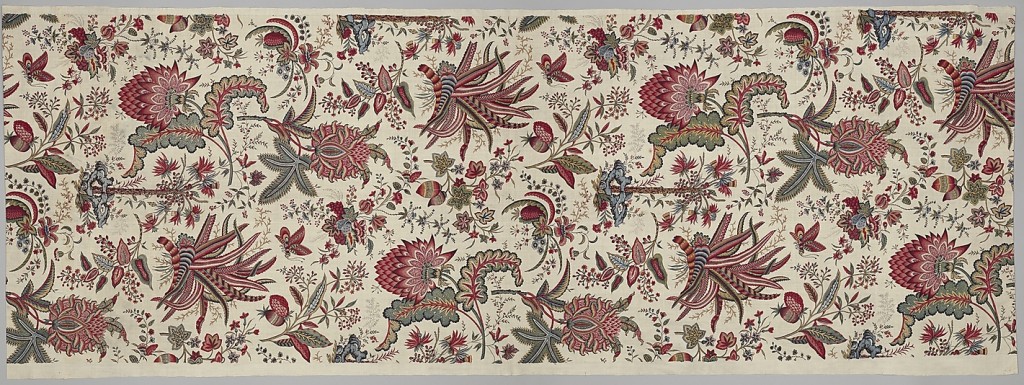Fabrics were some of the most expensive luxury materials in the eighteenth-century. Outfits were so expensive that they were often re-made as styles changed to keep up with fashion. Due to the high costs of fabrics, materials such as bed coverings were sometimes even repurposed as dresses. This re-working poses a challenge for dating fabrics. Clothes would even be left in wills and marriage contracts, as people only owned a few outfits throughout their lives. Even wealthy women owned no more than about twelve dresses in a lifetime. The repurposing of fabric was even more common among lower classes, because wealthier women could generally afford to update their wardrobes occasionally.
Silk was fashionable and came in many forms, including satin (glossy on one side, matte on the other), velvet, twill (diagonally woven ribs), taffeta (smooth), and brocade (woven with a loom). Brocade silks were particularly expensive, and thus were often passed down through generations. Silks came in different qualities, allowing lower classes the option of purchasing less durable materials. French silks were extremely popular, and most were produced in the towns of Lyon and Tours. These factories strove to meet popular demands for patterns, but also worked toward innovation in pattern design. Floral patterns were popular in brocaded silks, although these patterns were difficult to produce. Larger and more elaborate patterns were the most expensive because of the difficulty in making them, while plaids, stripes, and solid colors tended to be cheaper.
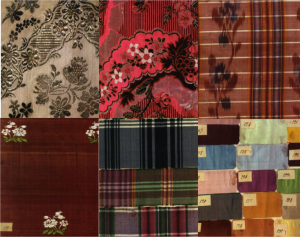
Different silks from sample books (top to bottom, left to right): Silk with silver thread, a pattern of woven damask, water-color style fabrics made from pre-dyed threads, tiny woven patterns, plaids, an assortment of solid colors
Using a loom required a weaver surrounded by many assistants who had to raise and lower different mechanical parts of the machine. Weavers faced many challenges, not only to use the loom efficiently, but also to calculate ways to conserve thread, particularly expensive gold and silver ones, and to recycle patterns to avoid rethreading the loom each time it was used. They also had to understand different types of yarns, and how to combine colors for the best, most cost-effective designs. The Lyon factory produced new designs each year, requiring its designers to be constantly creative, and to keep up with fashion trends. Each designer usually had a specialty pattern, such as a watercolor-style, or damask (a reversible weave), and worked with the weaver to be sure it was produced. The Lyon factory had approximately 34,000 workers, including men, women, and children. Despite the intense craftsmanship that was required for producing silks, most of the workers are not know today, aside from a few who made major innovations, such as using chinoiserie (East Asian influenced design), polychrome, and creating embroidery-style silks.
Silk was the most expensive luxury fabric, but the price of cotton was also high in the early eighteenth centurybecause much of it was imported from India. Fabric printing was a process that was perfected in India, and the European market rapidly consumed printed Indian cotton (called “Indiennes”) beginning in the seventeenth century. The process of printing cotton involved using mineral salts on block prints, which reacted with dyes, allowing for the production of vibrant colors. Prints could then be touched up with hand-painting. However, the French government disliked business leaving France for abroad, and thus banned the importation of cotton, though trade continued illegally with merchant sample books, which showed samples of the diverse fabric offerings available. The French eventually began printing cottons themselves, opening a factory in Oberkampf. As producing and printing cotton became a streamlined process in France, people below the aristocratic class began purchasing cottons, which were not as costly as linen and wool. However, more refined, printed cottons remained exclusive to upper classes, while the poor wore plainer cottons, often used for their working clothes.
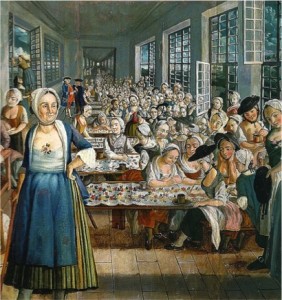
Oberkampf factory women printing and hand-painting cottons. Note the white cotton bonnets, a typical component of dress
The final main types of fabric worn were linen and wool. Linen was mostly used was undergarments and linings, because it soiled less easily than cotton. France’s factories produced different types of linens, with coarse linen for thick underskirts and the lining of stays, and light linen for underwear. Many linen producers eventually switched to cotton during the eighteenth century.
Wool had long been produced in France, and production was regulated by the government. The demand for wool did not increase as rapidly as for silk and cotton, but the industry did continue to grow over the course of the eighteenth-century. That era saw new dyeing techniques that allowed for the production of more colors, and for finer types of wool. Wool was usually woven in cities, then processed and dyed in surrounding towns. The largest center for wool fabric production was in Sedan. Wool became increasingly popular in upper classes, but lost out to cotton for the lower classes.
Once fabrics were produced, they were sent to be cut and assembled into outfits. As seen in the Encyclopédie plate below, tailors worked cross-legged on table so as not to dirty fabrics on the ground. In the background, you see a client being measured for an outfit. Clothing was custom-fitted, with each piece personalized to one’s specific measurements. Over the course of the eighteenth-century, women became the primary dressmakers, and stitching and tailoring became careful, practiced processes. Not only did dressmakers need to understand the processes of attaching pieces and constructing a dress, but they also needed to be aware of the rapidly changing fashion trends of the time.
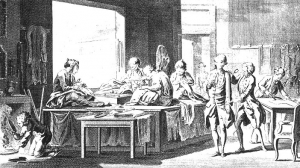
Encyclopédie plate depicting a tailor sitting cross-legged on a table while working fabric (left). In the background (right) can be seen a customer being measured for a fitted outfit
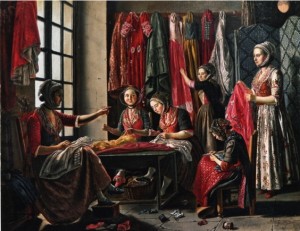
Antoine Raspal’s painting, “Sewing workshop in Arles” (1760), of women turning fabrics into clothing. Note outfits stored on pegs in background
For more information on clothing in eighteenth century France, please see:
Delpierre, Madeleine. Dress in France in the Eighteenth Century. Translated by Caroline Beamish. New Haven and London: Yale University Press, 1997.
Hart, Avril, and Susan North. Seventeeh and Eighteenth-Century Fashion in Detail. London: V&A Publishing, 1998.
Higonnet, Anne. “Textiles & Clothing.” Barnard College. Diana Center, New York, NY. 30 March 2015. Lecture.
Miller, Lesley. Selling Silks: A Merchant’s Sample Book 1764. London: V&A Publishing, 2014.
Roche, Daniel. “Towards the Understanding of the Parisian Clothing System.” In The Culture of Clothing: Dress and Fashion in the “Ancien Régime,” translated by Jean Birrell. Cambridge: Syndicate of the University of Cambridge, 1994.
Sewell, William H. “The Empire of Fashion and the Rise of Capitalism in Eighteenth-Century France.” Past & Present 206, no. 1 (February 1, 2010): 81–120. doi:10.1093/pastj/gtp044.
Starobinski, Jean, Philippe Duboy, Akiko Fukai, Jun I. Kanai, Toshio Horii, Janet Arnold, and Martin Kamer. Revolution in Fashion 1715-1815. Edited by Amy Handy. New York: Abbeville Press, 1989.
Wyngaard, Amy. “Switching Codes: Class, Clothing, and Cultural Change in the Works of Marivaux and Watteau.” Eighteenth-Century Studies 33, no. 4 (July 1, 2000): 523–41. doi:10.2307/30054161.
Image citations:
Diderot, Denis, and Jean Le Rond d’Alembert. Encyclopédie Ou Dictionnaire Raisonné Des Sciences, Des Arts et Des Métiers. Geneve: J.L. Pellet; [etc.], 1778.
Higonnet, Anne. “Textiles & Clothing.” Barnard College. Diana Center, New York, NY. 30 March 2015. Lecture.

